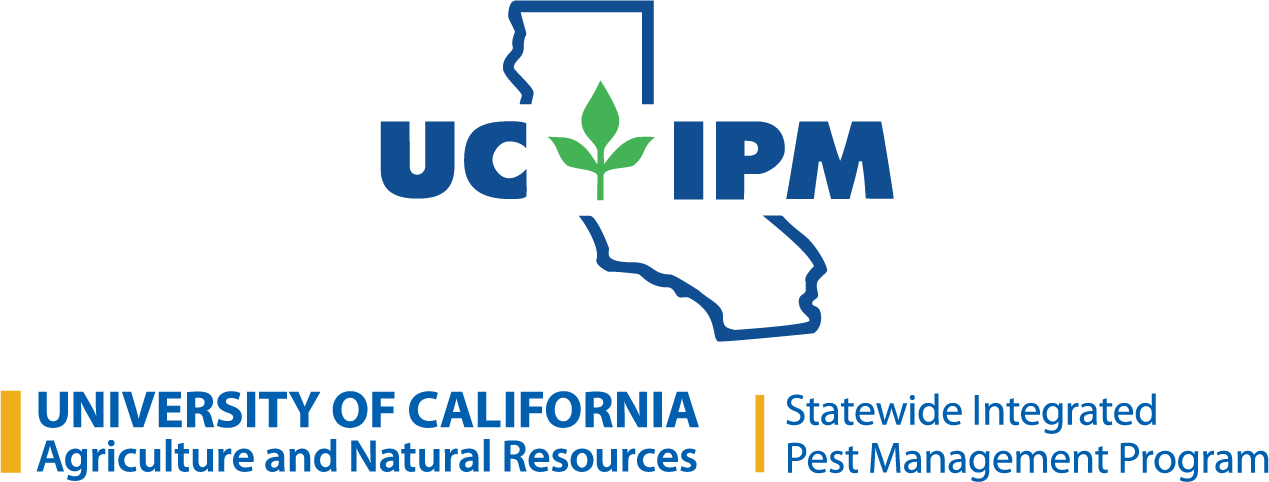Grapevines can host over 60 virus and virus-like pathogens that can cause a range of disease symptoms. The effects of some grape viruses are mild with little to no adverse effect on fruit yield. Other viruses cause serious diseases that can delay fruit ripening, reduce yield quantity and quality, and sometimes kill vines.
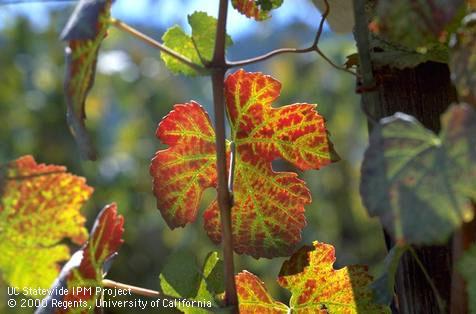
Identification
The most common and damaging viral diseases of grapevines are corky bark, fanleaf degeneration, grapevine red blotch disease, leafroll, and rootstock stem and lesion disease. The particular virus(es) present can be difficult to diagnose based only on symptoms. For example, the diseases corky bark, fanleaf degeneration, grapevine red blotch disease, and leafroll all can result in leaf reddening, yellowing, or both.
The first five diseases below are serious problems of grapevines. Of minor importance are fleck complex and rupestris stem pitting.
Corky bark. Grapevine virus B causes graft incompatibility symptoms. Around the graft union the rootstock, scion, or both may be atypically swollen, grooved or pitted, and develop necrotic lesions. Other symptoms can include delayed shoot growth during early spring, red or yellow foliage early in the summer, delayed fruit maturity and greatly reduced fruit quantity, and leaves that do not drop normally in fall but remain attached to the vine even after frost. The virus is introduced by budding or grafting with infected stock. It is also vectored by the longtailed mealybug, Pseudococcus longispinus.
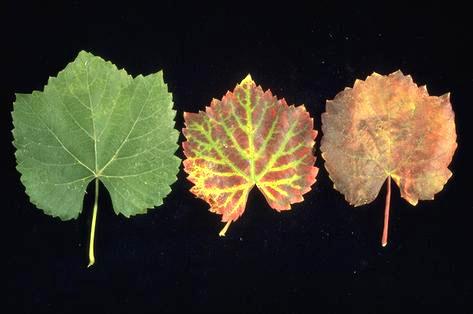
Fanleaf degeneration. Grapevine fanleaf virus infection causes poor berry set that can result in up to an 80% reduction in fruit yield. Affected clusters contain large and small berries and the small berries are seedless. Infected vines may be smaller overall than healthy vines. Canes and foliage appear clustered because of stunting. Internodes may be irregularly spaced and canes may develop secondary shoots.
Leaf symptoms caused by Grapevine fanleaf virus include:
- Distorted leaves that are asymmetric. The main veins are close together and teeth along the margin of leaves are elongated, giving the appearance of a fan.
- Mosaic, where leaves are bright yellow overall or in irregular patches. Intense yellow appears in early spring during cool weather and fades as temperatures increase.
- Vein banding, where bright yellow to whitish coloration develops along the major veins starting in early to midsummer. In California vein banding is the most common symptom of fanleaf degeneration.
The virus is mechanically transmissible during budding and grafting with contaminated stock. It is also spread by the soil-dwelling, root-feeding, dagger nematode (video) Xiphinema index.
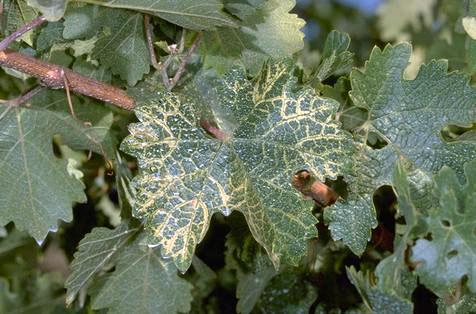
Grapevine red blotch disease. Grapevine red blotch virus greatly reduces fruit quality. Affected grapes have delayed maturity, high acidity, and low sugar. Foliage of infected plants turns partly or entirely red well before the normal time of fall color. Unlike the other viruses that cause premature leaf reddening, Grapevine red blotch virus also causes reddening of major veins on the leaf underside. Grapevine red blotch associated virus has primarily been spread during propagation with contaminated stock. The virus is also spread by the threecornered alfalfa hopper, Spissistilus festinus, and possibly other sap-sucking insects.
Leafroll. At least five Grapevine leafroll associated virus agents or groups of viruses cause this malady. Fruit quantity and berry quality are reduced by high acidity, late ripening, and low sugar. Symptoms are indistinct, especially during the dormant season and spring. Symptoms alone are not a reliable indication of infection.
Symptoms include delayed bud break and shoot growth in spring, grapevines that remain smaller than healthy vines, margins of leaf blades roll downwards beginning with the basal leaves, and areas between major veins turn red or yellow. These symptoms develop as fruit mature, especially after harvest before leaf fall.
Leafroll viruses have been introduced during propagation with infected stock. However, Grapevine leafroll associated virus-3 is vectored by mealybugs and scales. These insects may also vector some of the other viruses in this complex.
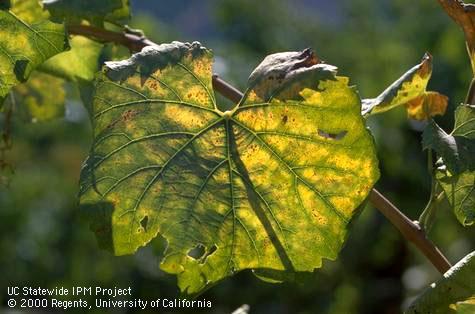
Rootstock stem lesion disease. The causal agent of this disease is named GLRaV-2RG. It causes graft incompatibility symptoms where the scion grows poorly and the union of rootstock and scion becomes atypically swollen with an irregular surface. Grapevines generally die within 1 to 3 years after becoming infected with GLRaV-2RG. There is no known vector of the pathogen. It spreads when an infected grape plant was used during propagation while budding or grafting.
Fleck complex. This malady is caused by a complex of viruses including Grapevine asteroid mosaic-associated virus, Grapevine fleck virus, and Grapevine rupestris vein feathering virus. Small veins on young leaves develop clearings (flecks, or color loss). On older leaves the clearings develop a mosaic pattern and the leaves curl upward and wrinkle. These viruses are introduced during propagation.
Rupestris stem pitting. Grapevine rupestris stem pitting-associated virus causes rootstock wood to become covered with many small pits. The pits are visible when bark is removed. Pits may expand to become grooves and occasionally cover the entire wood of the rootstock. The malady occurs in vines grafted to rootstocks with Vitis rupestris parentage. It is uncertain whether this infection reduces vine vigor. How this virus spreads is uncertain, but suspects include infected pollen and seed.
The development of symptoms from virus infection vary and some infections produce no symptoms at all. The severity of virus symptoms depends on factors including the cultivar of the grapes (scion and rootstock), the particular virus(es) present, weather, and the time during the growing season (e.g., spring versus summer or fall).
Solutions
Plant diagnostic laboratories can detect the presence of most known grape viruses in properly collected samples. Consult the laboratory before collecting samples to learn the timing and type of material to collect and how to handle and submit the samples.
Grapevines infected in the field cannot be cured of viruses. Virus management strategies are preventive, although providing vines a good growing environment and proper cultural care may at least temporarily reduce the extent of damage from infection.
Obtain grapevines from a reputable commercial supplier that is known to sell grapevines that are certified as free of known grape diseases. When grafting or budding grapevines, be certain to use only stock known to be virus free.
The most reliable way to avoid planting or budding virus-infected vines is to use plant material that has been certified to have been planted, grown and distributed under the California Registration & Certification (R & C) Program administered by the California Department of Food and Agriculture (CDFA). Such certified stock should be accompanied by an official tag issued by CDFA. Nurseries participating in the R & C program obtain their wood from the Foundation Plant Services at the University of California (UC), Davis. UC Davis has a foundation vineyard for major grape cultivars and clonal selections. Before planting in the foundation vineyard, selections are tested for viruses using various methods including biological indicators, as well as enzyme linked immunosorbent assay (ELISA) and advanced polymerase chain reaction (PCR). The foundation vineyard is visually monitored in spring and fall and a portion is retested each year for viruses known to be spread naturally in the field.
Because certain viruses are spread by sap-sucking insects such as mealybugs, scales, and treehoppers, effectively controlling insect vectors may help to avoid or reduce grapevine infection by certain viruses.
References
Adapted from A Bug That's Not Wanted in the Vineyards and Grape Pest Management Third Edition from the University of California Agriculture and Natural Resources also available as an eBook and Pest Management Guidelines: Grape, University of California Statewide Integrated Pest Management Program (UC IPM).
